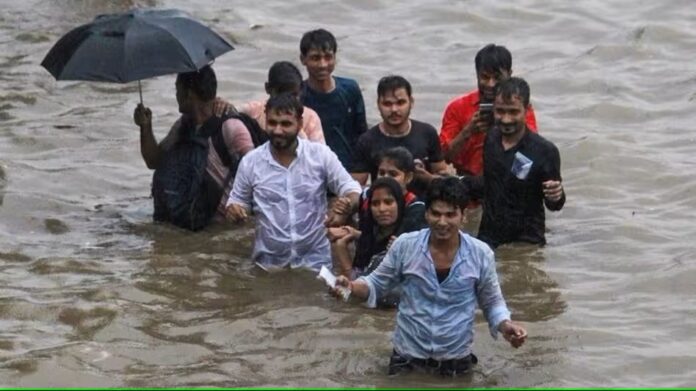August 2024 has brought relentless monsoon rains across various parts of India, with Delhi-NCR and Tripura being two regions severely impacted by the extreme weather. On one side, the national capital and its surrounding areas have been battered by torrential downpours, prompting the India Meteorological Department (IMD) to issue a ‘Yellow Alert’ for Delhi-NCR. Meanwhile, in the northeastern state of Tripura, flooding caused by incessant rains has taken a tragic toll, with the death count rising to 31 as rescue and relief efforts continue.
In the Delhi-NCR region, heavy rains started overnight, causing widespread disruptions in daily life. Commuters woke up to waterlogged streets, massive traffic jams, and delayed public transport services. Areas like Gurugram, Noida, and several parts of Delhi saw heavy water accumulation, affecting both local businesses and residential areas. The rains, which have been attributed to the convergence of monsoon winds and a low-pressure system, have left many low-lying areas submerged in knee-deep water. The IMD has issued a ‘Yellow Alert,’ warning residents of the possibility of continued heavy rainfall and advising them to stay cautious.
The IMD’s ‘Yellow Alert’ indicates that the weather could potentially worsen, urging residents to be prepared for any eventualities. In light of this, schools in several parts of the Delhi-NCR region have been advised to close, while government agencies are on high alert to deal with any emergencies. The continuous downpour has also led to concerns about the potential rise in vector-borne diseases like dengue and malaria, which are common during the monsoon season.
The national capital’s infrastructure has struggled to cope with the rain, as large parts of the city’s drainage system were overwhelmed by the volume of water. Major roads, including key arterial routes, have been blocked by waterlogging, leaving motorists stranded for hours. In some areas, residents have resorted to using makeshift boats to navigate flooded streets. Metro services, which are usually more resilient to weather conditions, experienced delays as well, adding to the commuter woes. The Delhi Traffic Police have issued advisories, urging people to avoid certain roads and exercise caution while driving.
While the situation in Delhi-NCR is challenging, the crisis in Tripura is far more severe. The northeastern state has been ravaged by unprecedented rainfall for several days, leading to flash floods and landslides in multiple districts. The death toll has now risen to 31, with many still missing or displaced due to the floods. The hardest-hit areas include Gomati, Khowai, and South Tripura districts, where entire villages have been submerged under floodwaters.
Rescue operations in Tripura are being led by the National Disaster Response Force (NDRF) and state authorities, who are working round the clock to evacuate people from flooded areas. However, the continuous rains have hampered relief efforts, with many roads becoming inaccessible and bridges washed away by the force of the floodwaters. Several hundred families have been moved to relief camps, but food, water, and medical supplies are running short in many areas, leading to concerns about the well-being of those displaced.
The flood situation in Tripura has also highlighted the state’s vulnerability to extreme weather events, exacerbated by climate change. Experts point to deforestation and poor urban planning as factors that have worsened the impact of the floods. Rivers like the Gomati and Howrah have swelled to dangerous levels, breaching embankments and flooding towns and farmlands. In addition to human casualties, livestock and crops have been severely affected, raising fears of a looming food crisis in some parts of the state.
Authorities in Tripura have appealed to the central government for additional resources and financial aid to manage the disaster. Prime Minister Narendra Modi, in a statement, expressed his condolences to the families of those who lost their lives in the floods and assured the state of all possible support. The Indian Army has also been deployed to assist in rescue and relief operations, particularly in remote areas that have been cut off from the rest of the state.
As both Delhi-NCR and Tripura grapple with the effects of the monsoon, the country is reminded of the fragility of its infrastructure and preparedness in the face of extreme weather. While floods and heavy rains are annual phenomena in India, the growing frequency and intensity of such events are a stark reminder of the challenges posed by climate change. Cities like Delhi, which are crucial economic hubs, need better flood management systems, while states like Tripura require stronger disaster preparedness and mitigation strategies to protect vulnerable populations.
With the monsoon season expected to continue for several more weeks, authorities in both regions are on high alert. The IMD has warned of further rainfall in the coming days, and efforts are underway to prevent further loss of life and property. In the meantime, residents of Delhi-NCR and Tripura are bracing for what remains a challenging and uncertain time.




